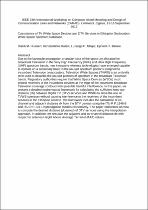 ResearchSpace
ResearchSpace
Coexistence of TV white space devices and DTV services in Ethiopian geolocation white space spectrum database
JavaScript is disabled for your browser. Some features of this site may not work without it.
- ResearchSpace
- →
- Research Publications/Outputs
- →
- Conference Publications
- →
- View Item
| dc.contributor.author |
Hussien, HM

|
|
| dc.contributor.author |
Katzis, K

|
|
| dc.contributor.author |
Mfupe, Luzango P

|
|
| dc.contributor.author |
Bekele, ET

|
|
| dc.date.accessioned | 2020-01-31T08:50:03Z | |
| dc.date.available | 2020-01-31T08:50:03Z | |
| dc.date.issued | 2019-09 | |
| dc.identifier.citation | Hussien, H.M., Katzis, K., Mfupe, L.P and Bekele, E.T. 2019. Coexistence of TV white space devices and DTV services in Ethiopian geolocation white space spectrum database. IEEE 24th International Workshop on Computer Aided Modeling and Design of Communication Links and Networks (CAMAD), Limmasol, Cyprus, 11-13 September 2019, 5pp | en_US |
| dc.identifier.uri | https://ieeexplore.ieee.org/document/8858472 | |
| dc.identifier.uri | DOI: 10.1109/CAMAD.2019.8858472 | |
| dc.identifier.uri | https://ieeexplore.ieee.org/stamp/stamp.jsp?tp=&arnumber=8858472 | |
| dc.identifier.uri | http://hdl.handle.net/10204/11290 | |
| dc.description | Copyright: 2019 IEEE. Due to copyright restrictions, the attached PDF file only contains the abstract of the full text item. For access to the full text item, kindly consult the publisher's website. | en_US |
| dc.description.abstract | Due to the favorable propagation characteristics of the spectrum allocated for broadcast Television in the Very High Frequency (VHF) and Ultra High Frequency (UHF) spectrum bands; new innovative wireless technologies have emerged capable to operate on a secondary basis in the unused spectrum portions assigned to incumbent Television broadcasters. Television White Spaces (TVWS) is an umbrella term used to describe the unused portions of spectrum in the broadcast Television bands. Regulatory authorities require that White Space Devices (WSDs) must protect receivers of the incumbent services at the edge of the incumbent broadcast Television coverage contours from possible harmful interference. In this paper, we present a detailed mathematical framework for calculating the sufficient keep-out-distance (d(subk) ) between Digital TV (DTV) services and WSDs to allow the use of TVWS spectrum without causing interference to the receivers of the incumbent services in the Ethiopian context. The framework includes the calculation of co-channel and adjacent distance d(subk)from the DTV contour using the ITU-R P. 1546-5 and ITU-R P.1411-9 propagation models respectively. The paper elaborates on how to compute the desired distance (d desired ) of DTV services using the interpolation approach. In addition, we simulate the adjacent and co-channel distance d(subk) with respect to antenna Height Above Average Terrain (HAAT) values. | en_US |
| dc.language.iso | en | en_US |
| dc.publisher | IEEE | en_US |
| dc.relation.ispartofseries | Worklist;23112 | |
| dc.subject | TV white space devices | en_US |
| dc.subject | Computer aided modelling | en_US |
| dc.title | Coexistence of TV white space devices and DTV services in Ethiopian geolocation white space spectrum database | en_US |
| dc.type | Conference Presentation | en_US |
| dc.identifier.apacitation | Hussien, H., Katzis, K., Mfupe, L. P., & Bekele, E. (2019). Coexistence of TV white space devices and DTV services in Ethiopian geolocation white space spectrum database. IEEE. http://hdl.handle.net/10204/11290 | en_ZA |
| dc.identifier.chicagocitation | Hussien, HM, K Katzis, Luzango P Mfupe, and ET Bekele. "Coexistence of TV white space devices and DTV services in Ethiopian geolocation white space spectrum database." (2019): http://hdl.handle.net/10204/11290 | en_ZA |
| dc.identifier.vancouvercitation | Hussien H, Katzis K, Mfupe LP, Bekele E, Coexistence of TV white space devices and DTV services in Ethiopian geolocation white space spectrum database; IEEE; 2019. http://hdl.handle.net/10204/11290 . | en_ZA |
| dc.identifier.ris | TY - Conference Presentation AU - Hussien, HM AU - Katzis, K AU - Mfupe, Luzango P AU - Bekele, ET AB - Due to the favorable propagation characteristics of the spectrum allocated for broadcast Television in the Very High Frequency (VHF) and Ultra High Frequency (UHF) spectrum bands; new innovative wireless technologies have emerged capable to operate on a secondary basis in the unused spectrum portions assigned to incumbent Television broadcasters. Television White Spaces (TVWS) is an umbrella term used to describe the unused portions of spectrum in the broadcast Television bands. Regulatory authorities require that White Space Devices (WSDs) must protect receivers of the incumbent services at the edge of the incumbent broadcast Television coverage contours from possible harmful interference. In this paper, we present a detailed mathematical framework for calculating the sufficient keep-out-distance (d(subk) ) between Digital TV (DTV) services and WSDs to allow the use of TVWS spectrum without causing interference to the receivers of the incumbent services in the Ethiopian context. The framework includes the calculation of co-channel and adjacent distance d(subk)from the DTV contour using the ITU-R P. 1546-5 and ITU-R P.1411-9 propagation models respectively. The paper elaborates on how to compute the desired distance (d desired ) of DTV services using the interpolation approach. In addition, we simulate the adjacent and co-channel distance d(subk) with respect to antenna Height Above Average Terrain (HAAT) values. DA - 2019-09 DB - ResearchSpace DP - CSIR KW - TV white space devices KW - Computer aided modelling LK - https://researchspace.csir.co.za PY - 2019 T1 - Coexistence of TV white space devices and DTV services in Ethiopian geolocation white space spectrum database TI - Coexistence of TV white space devices and DTV services in Ethiopian geolocation white space spectrum database UR - http://hdl.handle.net/10204/11290 ER - | en_ZA |





